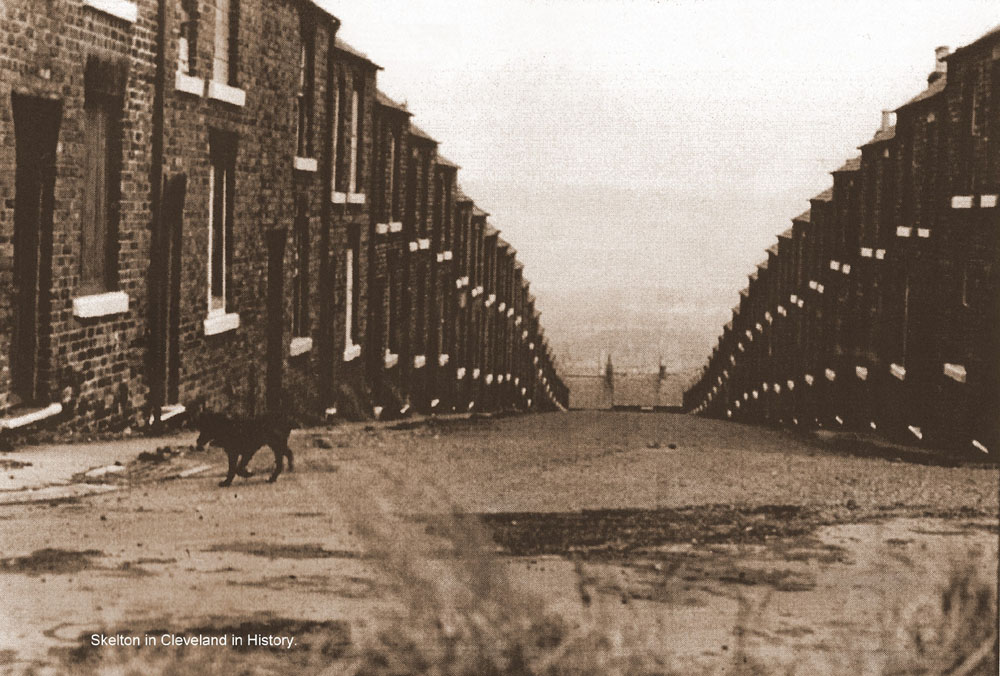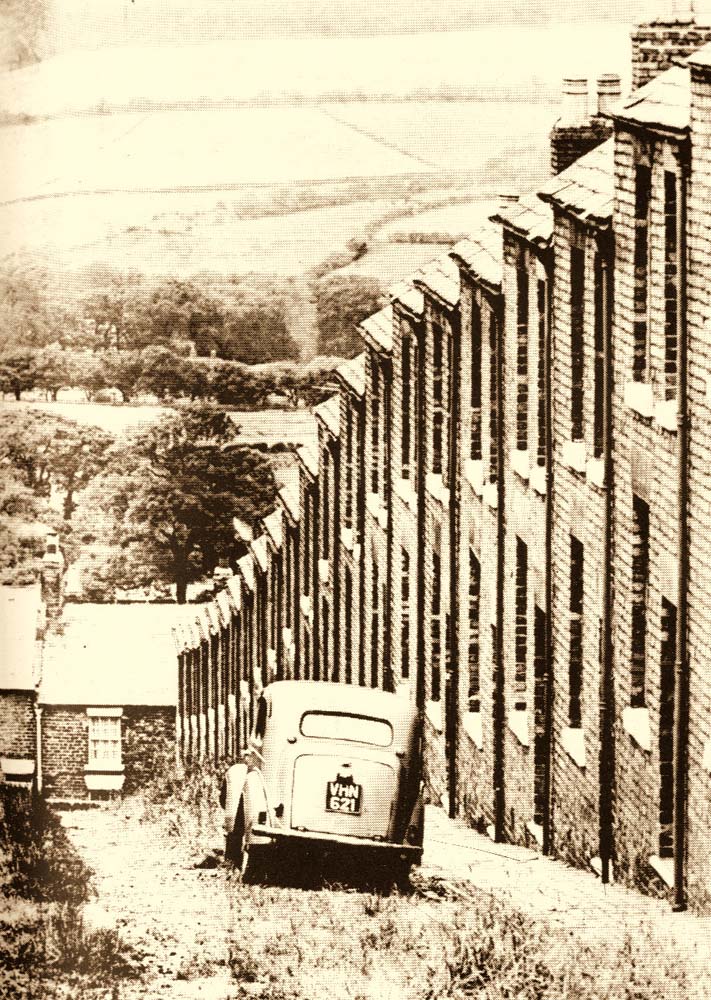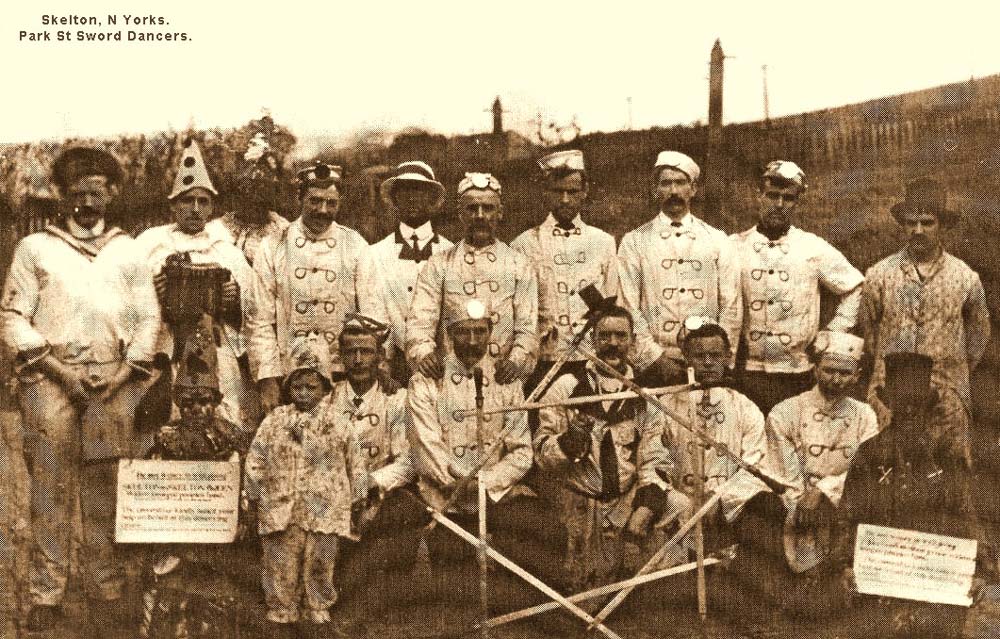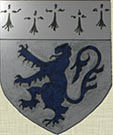Park Street. Skelton was typical of the terrace house life of Skelton ironstone miners. All the houses were owned by Bell Bros, who also owned Skelton Shaft and Skelton Park pits where most of the menfolk worked.
TOM CURNOW, a local historian, born in 1922 into this kind of life describes it thus:-
|

Park Street. Skelton. Miners' terrace houses.
|
"Mining was always very hard work, dangerous and unhealthy, working in terrible conditions, poor light, bad air, working sometimes to the knees in water.
There was always the danger of a roof fall, which could happen at any moment.
But even through all the groaning and creaking of the movement of rock above and the timber supports the trained ear of experienced miners could detect for the most of the part when a fall was about to happen.
Gas was one of the worst enemies and strict rules were enforced against matches and smoking.
In the early days a candle was the only source of light, this was often stuck in a piece of clay on the working face.
Most miners made their own lamps from an empty tin of some kind, the tin was held on its side by a piece of wire, with a hole to hold the candle and smaller holes pierced in the end, this was called the "midge".
There was a similar manufactured lamp that had glass sides and a little glass door at the front.
The carbide lamp came next, the bottom screwed off and was filled with calcium carbide, above which was a chamber of water that was regulated to drip onto the carbide producing acetylene gas which passed through a burner.
|

Park Street Front.
|
It was a messy affair and had a sickly smell.
I used to clean one for my father when I was a boy.
The much cleaner and safer Davey Lamp was introduced then the electric lamp, worked from a cell carried by the miner, fixed to his belt, with a lead to a lamp clipped to his safety helmet.
The road on which the miners worked could be level, rise or fall, according to the direction of the vein of ore ran.
The men usually worked in pairs at the face and these two would often work together for years, trusting each other for safety reasons as much as friendship.
Often these men wore only a pair of boots and a pair of football shorts when at work.
Water dripped from the roof in many places and impregnated the clothing with a smell of sulphur.
Many of the older miners chewed tobacco, because of not being allowed to smoke down the mine, this was accompanied by spitting.
Spitoons were positioned on the floors of the pubs and some had shallow troughs below the counter filled with sawdust, these were still in use up to the last war.
Some of these chaps were exceedingly crack shots, but others were not and the black leaded fire-places at home suffered.
Today steel arches are used in supports in the mines, but in the old days wooden props were used.
The miners always had an extra pocket stitched inside the jacket, which carried a clog of wood on the way home to keep the home fires burning.
Horses were used to pull the tubs to and from the work face and the shaft bottom, the tubs being loaded by hand and shovel before the introduction of power loaders.
Diesel locos eventually replaced the horses, the ore was transferred to a picking belt, where boys sorted the iron ore from shale and dogger.
|

Park Street. Sworddancers.
Their message reads - "Be not weary in well doing" - Skelton and Skelton Green Widows and aged peoples fund.
The committee kindly solicit your help on behalf of this deserving cause,
|
The ore was transported to the steelworks and the rest taken to a tip.
The miners started work at 6 a.m. and deputies at 5 a.m. so that they could examine the workings before the miners arrived.
They often had miles to walk to the mine and then walk miles underground to the working face.
Work finished at 2 p.m. and a six day working week.
The miners worked hard and often fought and drank hard also.
They had to make their own amusement because they never had enough money to do anything else.
They liked gambling, horses, greyhound racing, whippets, poaching, pigeons, and I think the main sport was football.
Living conditions were poor and furniture was sparse.
The fact that a lot of families in those days had many children and only two bedrooms, two beds or more had to be placed in each room, and often four to a bed.
It was not uncommon for some men to keep pigeons in a spare room if they had'nt a family, and even hens, birds and guinea pigs; this I have actually seen on many occasions.
Carpets were unheard of, you were doing well if you had lino and coconut matting.
|

Park Street back.
|
The fireplaces in miners homes were made of cast iron, with a side oven and probably a small boiler at the opposite side, kept clean with black lead, two brushes, a bit of spit and lots of hard work.
There would be a rail above the fireplace of either wood or polished brass, and even just a piece of rope, on which underwear was hung to air.
Most women did their own baking and made their own bread.
Oh-boy, the fresh warm crust covered in margarine and jam, what a treat.
Bath night meant getting the old tin bath off the hook in the yard and put by the fire, kettles and pans were boiled to fill the bath with water.
It would be an earth toilet at the far end of the yard and a copper in the corner to boil the water for wash days.
After the wash the clothes were hung across the street to dry, no need to worry about vehicles.
There was a spirit among mining families that was unique.
|
|



